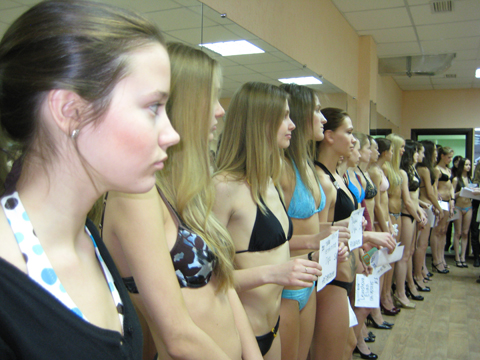
LINING UP To have their dreams shattered, young, far from home, and out of money. |
The opening shot of Girl Model, the 2011 documentary exposing the exploitative modeling industry in Russia and Japan, scans a gray and cold Siberian cityscape. The rest of the movie takes its cues from this first impression, leaving the viewer with a dreary and decidedly unglamorous perspective on the global business of beauty. If you ever had any doubts about the cynicism, emptiness, or vulgarity of the modeling world, this film will eliminate those completely.
Girl Model, by filmmakers David Redmon and Ashley Sabin (whose 2012 doc, Downeast, tells the story of post-industrial rural Maine), follows two main characters: Nadya, a sweet and soulful 13-year-old from Siberia, and Ashley, a former model who now works as a model scout, touring the Russian countryside to identify the next fresh face. She sends the girls she likes to Japan, where clients want girls who look cute, young, and innocent ("prepubescent," Ashley admits at one point) for fashion campaigns and magazine photo shoots. Nadya, all lithe and blue-eyed and snub-nosed, fits the bill.
So she's shipped by plane to Tokyo, not much different than a product in plastic packaging, leaving her family behind in favor of dingy dorm-room style living quarters (shared with another young Russian girl, Madlen) and a hectic schedule of seemingly fruitless casting calls. The system appears to be designed to break adolescent females like Nadya and Madlen. Their contracts are Byzantine and absurd — they are warned not to gain even one centimeter on their waist or hips; the wording is liable to change "on a day-to-day basis." They are promised at least two booked jobs and $8000 but (surprise!) these rewards never materialize. They have trouble communicating with family back home. They have no money.
Meanwhile, we are afforded a fast-forward glimpse at the industry's long-term effects, in the form of Ashley's ambivalent reflections on her own life.
"The business of modeling is not something I feel necessarily passionate about," she says, staring out the window of the Trans-Siberian railroad. "Because it really has no weight . . . it's based on nothing."
At her glossy Connecticut home, where she lives alone, we are introduced to Ashley's two naked baby dolls, which she places gently on the couch (no further explanation is offered for these bizarre talismans). She shows the cameramen her strange collection of photographs, disjointed images of body parts, hands, and feet. These moments are interspersed with footage from Ashley's past, camcorder recordings of her own experience as an 18-year-old model in Japan. The girl in these scenes is depressed, scared, angry. When she was entrenched in it, she "hated this business more than anyone," Ashley says. Then why is she still a cog in the machine?
On many levels, this is a movie about delusions. Nadya and Madlen are deluded into thinking they will make it big in Japan, just as their family believe their daughters will be able to lift them out of poverty. The man who runs the scouting agency that discovers Nadya fancies himself to be something of a savior. "I am trying to save all these young girls," he says with a perfectly straight face, right after telling Ashley that he sometimes takes the models to a St. Petersburg morgue in order to impress upon them the dangers of drug abuse. And Ashley herself seems to fight an ongoing battle to become more delusional, to not see or to ignore the truths of the industry she supports and feeds.